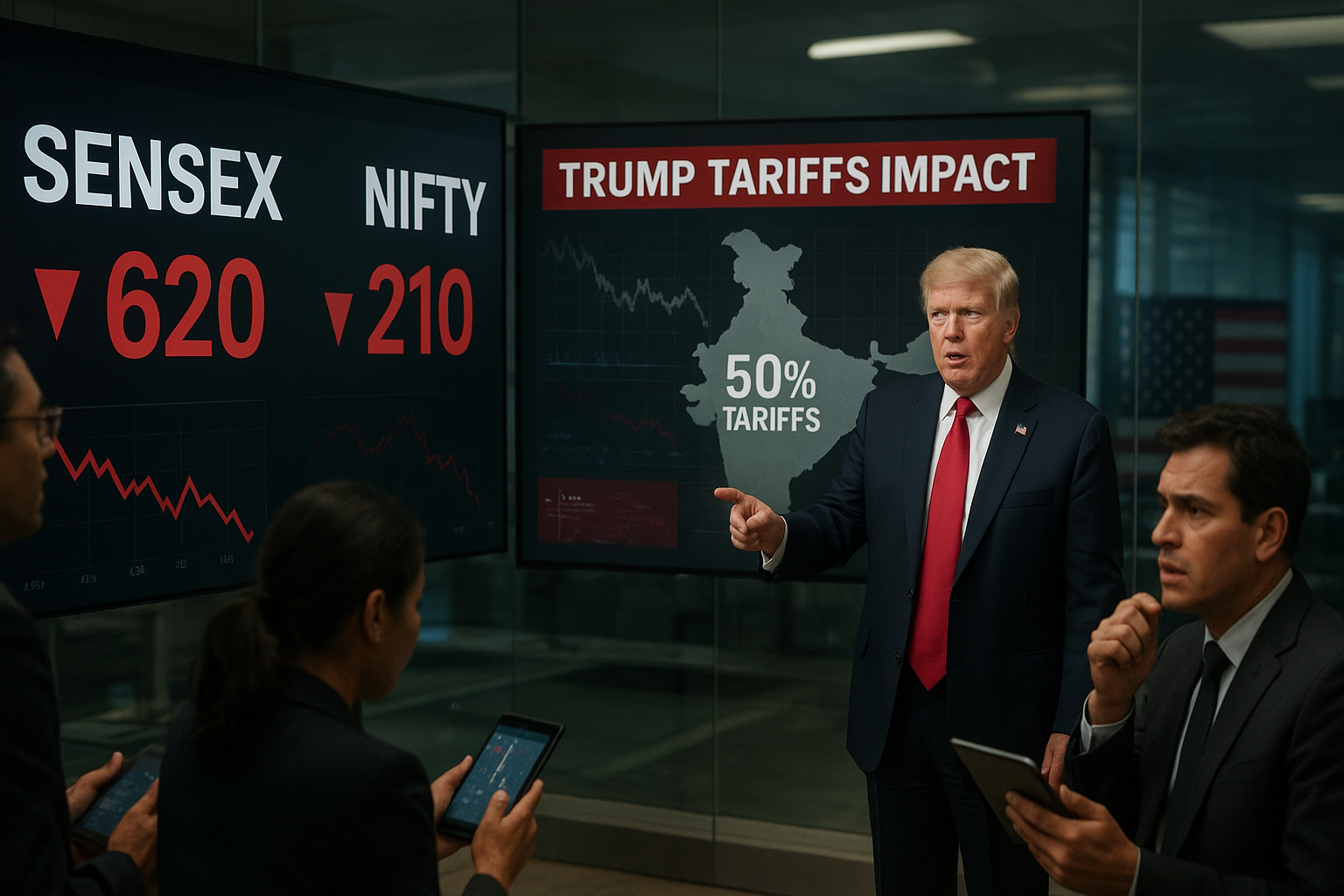Last Updated: 28 August 2025, 11:00 AM
U.S. Tariffs on Indian Exports The Primary Reason for the Market Crash

On August 27, 2025, the U.S. imposed Trump tariffs on Indian exports, triggering a sharp fall in the Indian stock market. The Sensex dropped 700 points and the Nifty 50 fell 1%, reaching 24,514.35. The market capitalization of BSE-listed companies declined by ₹4 lakh crore, raising concerns about capital outflows and corporate earnings. This is the main reason why market crashed today.
Sectors most affected include textiles, apparel, gems and jewelry, seafood, and furniture. Exporters are facing revenue losses and some are considering moving production to Bangladesh and Vietnam. In the seafood industry, shipments fell over 75% in August, while textile and apparel companies fear job losses due to declining U.S. orders, impacting both businesses and employment in export-reliant regions.
Economists estimate a $33 billion loss in exports and a 20 basis point dip in GDP. The Trump tariffs have disrupted trade agreements and created uncertainty in sectors like pharmaceuticals and high-value textiles. Analysts warn that India may need long-term adjustments in supply chains and alternative markets to maintain growth.
The Indian government announced measures to cushion the impact. Prime Minister Narendra Modi unveiled a $12 billion income tax cut and a simplified GST system to boost domestic consumption. “Make in India” initiatives are being promoted to strengthen domestic manufacturing and reduce dependence on export markets vulnerable to trade disputes.
The imposition of Trump tariffs on Indian exports is the primary reason why market crashed today. While government measures may offer temporary relief, the full economic impact will unfold over the coming months, influenced by trade negotiations, sectoral adjustments, and investor sentiment.
Impact on Export Revenues
The recent Trump tariffs on Indian exports have significantly affected India’s export revenues, especially for sectors heavily reliant on the U.S. market. Industries such as textiles, apparel, gems and jewelry, seafood, and furniture are facing sharp declines in shipments and order cancellations.
- Seafood exports fell by over 75% in August.
- Many textile and apparel companies struggle to fulfill reduced orders.
This sudden drop in export revenue has put pressure on cash flows, threatened business sustainability, and created fears of job losses in export-dependent regions. Analysts estimate a $33 billion loss in export income, highlighting the severity of the Trump tariffs’ impact on India’s trade balance and economic growth.
Investor Concerns
The Trump tariffs have triggered widespread investor concerns, as market volatility intensified following the announcement.
- Sensex fell nearly 700 points.
- Nifty 50 dropped 1%.
Investors are worried about capital outflows, declining corporate profits, and the uncertainty surrounding trade negotiations with the U.S. Many are now reevaluating portfolios, reducing exposure to companies heavily dependent on U.S. orders, and seeking safer investment avenues.
Analysts suggest that while domestic consumption may provide some buffer, ongoing market instability has raised fears of prolonged volatility, making investor sentiment cautious in the short term.
Sector-Specific Pressure
The Trump tariffs on Indian exports have created intense pressure on specific sectors that are highly dependent on overseas demand. Textiles and apparel companies are facing order cancellations and shipment delays, threatening both revenue and employment in export-heavy regions. Many firms are considering relocating production to countries like Bangladesh and Vietnam to avoid the steep tariffs, which could have long-term consequences for India’s export competitiveness.
- Textiles & Apparel: Order cancellations and shipment delays threaten revenue and jobs. Some firms may relocate production to Bangladesh or Vietnam.
- Seafood: Shipments in August declined over 75%, affecting coastal livelihoods.
- Gems & Jewelry: U.S. orders have slowed, impacting exports.
- Furniture & Carpets: Rising costs and decreased demand create adaptation challenges.
Similarly, the seafood industry has been hit hard, with shipments in August declining by over 75%, affecting the livelihoods of coastal communities. The gems and jewelry sector has also seen a slowdown in U.S. orders, while furniture and carpet manufacturers struggle to adapt to rising costs and decreased demand. These sector-specific challenges highlight the vulnerability of India’s export-driven industries and underscore the urgent need for government intervention and strategic planning to sustain growth.
- The main reason is the imposition of Trump tariffs on Indian exports.
- Investor concerns and sector-specific pressures increased volatility.
- Market sentiment was affected due to uncertainty in trade negotiations with the U.S.
- Sensex fell 620 points.
- Nifty dropped 210 points.
- The fall occurred immediately after the Trump tariffs announcement.
- Textiles & Apparel
- Gems & Jewelry
- Seafood and Furniture
- Exporters face revenue losses and shipment delays.
- Some companies are considering relocating production to Bangladesh or Vietnam.
- Job security and business sustainability are at risk in export-heavy regions.
- Many reduced exposure to companies dependent on U.S. orders.
- Portfolios were reevaluated for safer investment options.
- Investor sentiment became cautious due to market volatility.
- Analysts estimate a $33 billion loss in export income.
- India’s trade balance and GDP growth are affected.
- Sectors heavily dependent on U.S. exports face long-term challenges.
- Tax cuts and GST simplifications have been announced.
- “Make in India” initiatives are promoted to boost domestic manufacturing.
- Measures aim to reduce reliance on export markets vulnerable to trade disputes.
